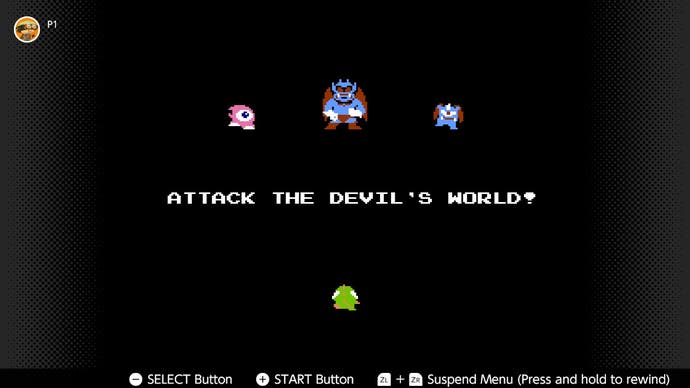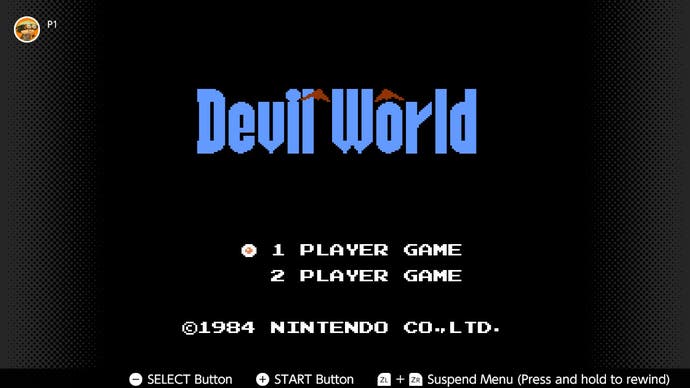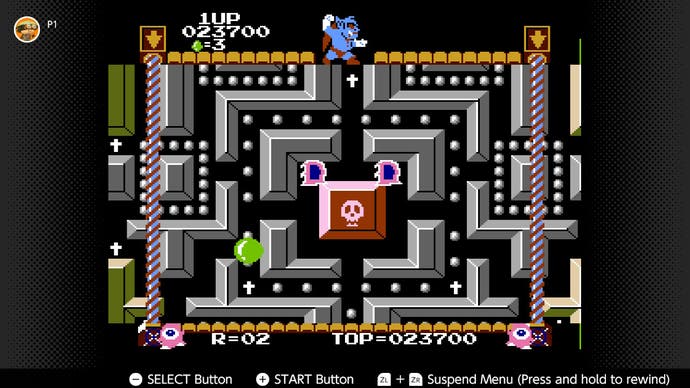A look at Miyamoto's weird gem Devil World
Cross-y roads.
I've always been fascinated by Devil World, a game that Shigeru Miyamoto made for the Famicom back in the early 1980s. It was, I gather, his first game made exclusively for a console. Devil World's a spin on Pac-Man, but one that never made it to the West because it used a lot of religious imagery. Devils, sure, but also bibles and crosses. It's always sounded weird and intriguing.
Now, Devil World has finally landed on the Nintendo Switch, and I've been playing it on and off for the last few days. It's certainly a little strange to see a Nintendo game in which you collect bibles and get powered-up by crosses, and looking back at a screenshot I took which has a huge crucifix for the player to navigate I did feel the vaguest frisson of something or other. But the iconography is far from the most interesting thing about this game, I suspect. Let's dig in.
As I mentioned, Devil World's clearly inspired by Pac-Man, and that alone makes it worth looking at. Why? Because here's Miyamoto working with a very established game design to build upon. (His fellow designer, Takashi Tezuka, had apparently not played Pac-Man when he began work on the game, but he soon got caught up, and apparently really enjoyed the original.) So what does Miyamoto do?


He layers stuff on. And he tweaks the variables in interesting ways. In Pac-Man - stop me if you know this - you wander around a maze eating dots and being pursued by ghosts. The ghosts kill you if they touch you, unless you've just eaten a power pill, which allows you to flip the tables and kill them.
It's ingenious stuff, but Miyamoto and Tezuka can't help tinkering with it. There are still dots in Devil World, and there are pursuing monsters who work very much like Pac-Man's ghosts, chasing you through the maze. But the crosses, which stand in for the power pills, work a little differently. Pick one up and you can suddenly breathe fire, which allows you to attack the monsters who are after you. On top of that, though, you can only collect dots while you have a cross in your possession.
This does quite a lot for the drama of the game, if you ask me. Pac-Man's about navigating the maze and using those power pills at the correct time, sure, but Devil World cranks that up quite a bit. Unless you're thinking about collecting crosses, just navigating the maze is pointless because you can't collect anything. A second kind of stage, which comes slotted in between the main stages, doubles down on this idea. Suddenly there are no dots, but you need to collect four bibles, one at a time, and use them to close a kind of seal in the middle of the maze that allows you to then progress to the next stage where it all repeats. Without the bibles you can't spit fire, but you also can't start to close the seal. This is a game where the power-ups really define your thinking.
But there's another aspect to Devil World which I actually find even more interesting. This is pretty ingenious, actually. The maze moves.

So as you race around collecting crosses, eating dots, and dealing with those monsters, the maze itself is scrolling. It loops, so anything that scrolls off the left side instantly reappears at the right, and the same goes for the top and the bottom. But it doesn't just loop. There are hard barriers at the four sides of the screen, and these are separate to the walls of the maze itself. They stay in place.
What this means is that you can get squashed between a shifting wall of the maze and an immovable wall at the edge of the screen. You can get caught and die! This fundamentally transforms the way you think about the mazes, because all of a sudden you're really looking at the length of each path, and the amount of time it will take to move along it. If the maze moves in the wrong direction when you're on that path, are you going to be able to get out?
And that's the final thing: the direction in which the maze moves isn't set. It's actually orchestrated by a big devil character who sits at the top of the screen and commands little minions at the corners to roll the maze in certain directions.

I absolutely love these elements. Not only does it give you something else to keep an eye on as you're playing - what does that devil have in mind for the maze? - it also plays around with the idea of a game's UI in interesting ways. There's the score, fine, and how many lives you have left, but then part of the stuff that drives the game is pretending to be mechanical: the maze is only moving because of the trundling work of those monsters.
Devil World feels very fresh to me. It's a game I've known about for a long time, but now I've played it, I feel like I'm getting its playfulness directly transmitted, with no cobwebby time coming between the game design and its various fancies and then me on the other side of the screen. More than that, I get this weird time-warp feeling where I look at Devil World and catch a glimpse of something I've seen in other games by Miyamoto - and other games by Tezuka.
This comes down to that part about being squished by the screen. It's so clearly a part of the design, a hurdle to navigate. And yet! Years back, when my sister and I used to play the original 2D Marios, and occasionally you'd get a scrolling level and occasionally on that level you'd get squished, we always used to argue about whether this was an intentional part of the design or whether it was just a result of the screen moving, an unfortunate accident. Looking back now, it was clearly intentional and we were just being dense - I was just being dense, I mean. I think my sister totally understood what was going on. But anyway, here's another game by the same people and it has the same mechanic - and this time there's no doubting how intentional it is. Brilliant stuff.








